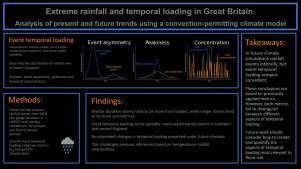英国的极端降雨和时间负荷:使用允许对流的气候模式分析现在和未来趋势
IF 5
2区 地球科学
Q1 WATER RESOURCES
引用次数: 0
摘要
研究区域:英国研究重点:虽然气候变化正在加剧极端降雨,但其对时间负荷的影响仍然知之甚少。时间荷载,即降雨在风暴持续时间内的分布,影响着给定体积的风暴的洪水风险,对城市基础设施规划至关重要。本研究首次对气候预估中的事件时间负荷进行了直接调查,利用UKCP局地对流允许的集合模拟。在雨量计地点,我们对每年持续时间为1.5至24小时的最极端风暴进行采样,并应用两种分类指标来评估风暴的时间结构。该地区的新水文见解:我们的分析证实,在今天的气候中,持续时间较短的风暴往往是前置的,而持续时间较长的风暴则表现出更集中、对称的强度分布。空间模式显示,英格兰中部和南部表现出更高比例的高度不对称事件。然而,在未来气候条件下,预计时间负荷没有一致的变化,这对先前基于温度-降雨关系的推断提出了挑战。这些差异可能源于英国和以前研究过的热带地区在风暴产生机制上的差异。我们的研究结果突出了当前指标的局限性,这些指标不能充分区分风暴结构对时间负荷的影响。我们建议开发精细的指标来独立量化事件不对称性、峰值强度和时间。这些进步对于改善设计洪水模型以及未来气候情景至关重要。本文章由计算机程序翻译,如有差异,请以英文原文为准。

Extreme rainfall and temporal loading in Great Britain: Analysis of present and future trends using a convection-permitting climate model
Study Region:
Great Britain
Study Focus:
While climate change is intensifying rainfall extremes, its effect on temporal loading remains poorly understood. Temporal loading, the distribution of rainfall over storm duration, influences flood risk for storms of a given volume and is critical for urban infrastructure planning. This research presents the first direct investigation of event temporal loading within climate projections, utilising UKCP Local convection-permitting ensemble simulations. At rain gauge locations, we sample the most extreme storm each year at durations from 1.5 to 24 hours and apply two classification metrics to evaluate storm temporal structure.
New Hydrological Insights for the Region:
Our analysis confirms that in today’s climate, shorter-duration storms tend to be front-loaded, while longer storms exhibit more centred, symmetrical intensity profiles. Spatial patterns emerge with central and southern England exhibiting a higher proportion of highly asymmetric events. However, no consistent changes in temporal loading are projected under future climates, challenging previous inferences based on temperature–rainfall relationships. These discrepancies may stem from differences in storm-generating mechanisms between Great Britain and tropical regions studied previously. Our findings highlight limitations of current metrics, which inadequately distinguish aspects of storm structure contributing to temporal loading. We recommend developing refined metrics to independently quantify event asymmetry, peak intensity, and timing. Such advancements are crucial for improving design flood modelling alongside future climate scenarios.
求助全文
通过发布文献求助,成功后即可免费获取论文全文。
去求助
来源期刊

Journal of Hydrology-Regional Studies
Earth and Planetary Sciences-Earth and Planetary Sciences (miscellaneous)
CiteScore
6.70
自引率
8.50%
发文量
284
审稿时长
60 days
期刊介绍:
Journal of Hydrology: Regional Studies publishes original research papers enhancing the science of hydrology and aiming at region-specific problems, past and future conditions, analysis, review and solutions. The journal particularly welcomes research papers that deliver new insights into region-specific hydrological processes and responses to changing conditions, as well as contributions that incorporate interdisciplinarity and translational science.
 求助内容:
求助内容: 应助结果提醒方式:
应助结果提醒方式:


